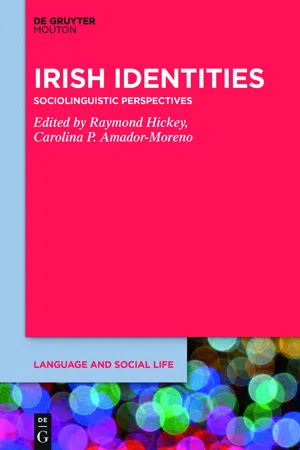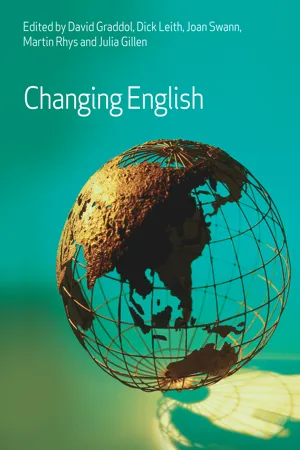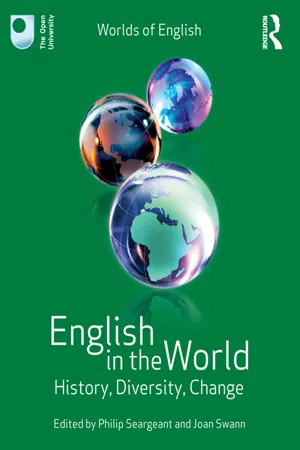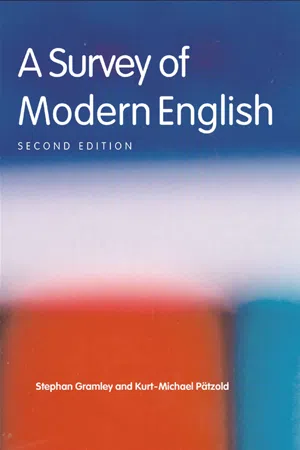Languages & Linguistics
Irish English
Irish English refers to the various dialects and forms of the English language spoken in Ireland. It is influenced by the Irish language and has distinct phonological, grammatical, and lexical features. Irish English reflects the historical and cultural influences on the language, and it continues to evolve as a unique variety of English.
Written by Perlego with AI-assistance
Related key terms
Related key terms
1 of 4
Related key terms
1 of 3
7 Key excerpts on "Irish English"
- eBook - ePub
Irish Identities
Sociolinguistic Perspectives
- Raymond Hickey, Carolina P. Amador-Moreno(Authors)
- 2020(Publication Date)
- De Gruyter Mouton(Publisher)
For urban Irish English an additional social dimension arose (see contributions in Hickey ed., 2016) with vernacular varieties offering a unique profile for many city dialects such as those in Dublin (Hickey 2005) or Cork. The extent to which ethnicity is reflected in language differences was investigated for Derry by Kevin McCafferty some years ago (McCafferty 2001) and adds a further dimension to identity issues, one which is not present in the Republic of Ireland or only with the non-Irish born, the so-called New Irish or non-nationals (Diskin and Regan 2015). Linguistic identity manifests itself on different levels of language. For instance, on the phonetic level there are newly adopted features from American English (Hickey 2016) and, with these, young people in Ireland today have been developing new profiles for the sound system of Irish English. This is true on the grammatical level (Filppula 2012 ; van Hattum 2012 ; Ronan 2005 ; Siemund and Beal 2011) and not least on that of pragmatics where Irish English has a unique profile (Barron 2017) vis à vis other varieties of the English language and which it continues to maintain. The use of specific discourse markers (Amador-Moreno 2005, 2010 : 119–123; Vaughan and Clancy 2011; Murphy and Farr 2012) in colloquial speech and in fictional representations (Amador-Moreno 2016 ; Amador-Moreno and Terrazas-Calero 2017 ; Barron 2017), and indeed in translations (Cronin 2011), attest to the vitality of this key variety of English and the strong function it serves in contemporary Irish society as a carrier of identity for its speakers. It is hoped that the chapters in the present volume will contribute to an understanding of the dynamics of linguistic identity in today’s world (Evans ed., 2015) by highlighting aspects of the Irish context which are of general relevance, e.g. to post-colonial societies (Sandhu and Higgins 2016) of the anglophone world, or other regions of Britain (see McColl Millar 2010) - eBook - ePub
- David Graddol, Dick Leith, Joan Swann, Martin Rhys, Julia Gillen(Authors)
- 2020(Publication Date)
- Routledge(Publisher)
1 English voices Joan Swann 1.1 Introduction Since you are reading this book, the chances are that you are quite fluent in English, though it may not be the only language you speak and it may not be your first language. Different readers will speak, or be familiar with, different varieties of English; they will have different experiences of using English, and maybe different feelings about the language. Such diversity is a major theme running through this chapter, and in fact through the whole of this book. Here, I look at some of the ways in which the English language varies and changes, at the diversity of speakers of English, and at how English is used and what it means to its speakers in different parts of the world. 1.2 What counts as English? The Scots, the Irish and the Welsh all speak English, and some also speak a Celtic language, so that one can talk of ' Scottish Gaelic' and ' Scottish English', as well as 'Irish Gaelic' and 'Irish English'. These lead on contrastively (and inevitably) to ' English English', a term now common among scholars of the English language. Furthermore, varieties of the 'same' language can be mutually incomprehensible: in England, a Cockney from London and a Geordie from Newcastle may or may not always understand one another; in the United States, & Texan may not always grasp what a New Yorker is saying; and in the wider world a Jamaican may not be transparent to someone from New Zealand. Yet all have used 'English' all their lives. (McArthur, 2002, p. 7) [O]ur Grammar aims at... comprehensiveness and depth in treating English irrespective of frontiers: our field is no less than the grammar of educated English current in the second half of the twentieth century in the world's major English-speaking communities - eBook - ePub
English in the World
History, Diversity, Change
- Philip Seargeant, Joan Swann(Authors)
- 2013(Publication Date)
- Routledge(Publisher)
he’s going …) is largely confined to late anglicisation areas and can be connected to the influence of Welsh.Finally, the influence of the Welsh language is said to be particularly evident in prosody (a feature of pronunciation that includes stress, rhythm, intonation, etc.). John Wells (1982, p. 392) notes that ‘[p]opular English views about Welsh accents include the claim that they have a “sing-song” or lilting intonation’ and this may have substance in linguistic analysis: the vowel in the final unstressed syllable for words such as sofa and butter is lengthened and has a fuller quality when compared to standard English in England, and this may be perceived as melodic. This is attributed to the Welsh language, where final unstressed syllables are not reduced, and is a feature generally shared throughout Wales.The examples above provide a snapshot of the different influences on the development of English in Wales, and how these impact on present-day dialects of Welsh English.English in Ireland
The use of English in Ireland dates back to 1250, but just as in Wales, widespread use did not come about until much later, around the seventeenth century, with the organised colonisation of Ireland by the British Crown.Hickey (2007, p. 142) states that ‘it is obvious that linguistically, as well as politically, Ireland is divided into two broad sections, the north and the south’ and these are largely related to patterns of settlement. The broad dialect areas are shown in Figure 5.4 .Figure 5.4 Dialect areas in Ireland (Hickey, 2004)The northern area can be further divided into three major dialect regions which developed during the period of colonisation: Ulster Scots, derived from the Lowland Scots settlers; Mid-Ulster English, derived from settlers coming largely from northern England; and a variety spoken in the west of Donegal arising from forms of Ulster English in contact with Irish. Added to these three main varieties is the capital of Belfast, where a number of different varieties converge. - eBook - ePub
- Stephan E Gramley, Michael Pátzold(Authors)
- 2004(Publication Date)
- Routledge(Publisher)
Gaeltacht, Irish is still spoken; and Irish is the Republic’s official language (together with English, the second official language). The percentage of population who actually speak Irish is, however, very low (around two per cent).10.3.1 Northern Ireland
The split in Ireland as a whole is reflected once again within the historical province of Ulster, which is partly in the Republic (the three counties of Cavan, Donegal and Monaghan) and partly in Northern Ireland. The population of Northern Ireland itself is divided very much along confessional lines, somewhat under one half Roman Catholic (the Republic is over 90 per cent Catholic) and the remainder chiefly Protestant. This, too, reflects the historical movement of people to and within Ireland. The northern and eastern parts of the province are heavily Scots and Protestant; the variety of English spoken there is usually referred to as Ulster Scots or, sometimes, Scotch-Irish. Further to the south and west the form of English is called Mid-Ulster English, and its features increasingly resemble those of English in the South, with South Ulster English as a transitional accent.The same split, but also new, mixed or compromise forms, can be observed in Belfast, which at approximately half a million is the largest city in Northern Ireland and second only to Dublin in all of Ireland. Although there is a great and ever growing amount of sectarian residential patterning, speech forms in the city as a whole are said to be merging (Barry 1984: 120). Harris, for example, states: ‘The vowel phonology of Mid Ulster English can be viewed as an accommodation of both Ulster Scots and south Ulster English systems’ (1984: 125). Phonetically, however, there are distinct Ulster Scots and South Ulster English allophones in Belfast. One of the most potent reasons advanced for the increasing levelling of speech forms is the weakening of complex (’multiplex’) - eBook - ePub
Immersion Education
Lessons from a Minority Language Context
- Pádraig Ó Duibhir(Author)
- 2018(Publication Date)
- Multilingual Matters(Publisher)
Pupils in all-Irish schools, located outside the Gaeltacht, depend on dispersed networks of Irish speakers to come in contact with Irish. In circumstances where the language is not visible to pupils outside the context of the school, their motivation to learn the language may weaken as the language structures become more complex. Pupils may not sustain the effort required to acquire the more difficult structures of Irish if they do not see a practical application for their efforts in their lives outside of school.Most active Irish speakers live in social contexts that are heavily influenced by the increasing language contact between Irish and English. The global dominance of English is also increasing the extent of code-mixing of the two languages which is a common feature of the speech of Irish speakers (Nic Eoin, 2005). O’Malley Madec (2007) noted in her research that native speakers of Irish in all age groups use a significant amount of English words and phrases in their speech. Her study of English discourse markers led her to classify them as borrowings rather than code-switches and found that the more formal an interaction was, the fewer borrowings there were. Speakers appeared to use English discourse markers to denote a speaker style. In a study of adult native speaker Gaeltacht pre-school stiúrthóirí (leaders), Hickey (2009) found that over three-quarters of their code-switches were made up of a small number of English discourse markers. This use of English has led writers such as Nic Pháidín (2003) to refer to the Irish spoken in the Gaeltacht areas as a creole. The language lacks the richness that it once had and is now heavily influenced by English syntax (Ó Baoill, 1981), and indeed Mac Mathúna (1997) goes so far as to state that one cannot be certain that native speakers have even a grasp of correct grammatical structures.A comprehensive linguistic survey of young people of post-primary age in Gaeltacht areas highlighted the process of language shift and a decrease in their levels of proficiency (Ó Giollagáin et al ., 2007; Ó Giollagáin & Charlton, 2015). While 67% of young people in the Gaeltacht describe their level of proficiency in the Irish language as ‘fluent’ or ‘very good’, only 10% claim their proficiency in Irish is greater than in English. This contrasts with Wales where 89.4% of pupils from Welsh-speaking homes felt more comfortable speaking Welsh than English while only 5.6% of pupils from English-speaking homes and attending Welsh-medium education felt the same (Thomas & Roberts, 2011). A significant number of young people in the Gaeltacht also have difficulty with written language. Among the language areas proving most difficult were spelling, grammar and a deficient vocabulary, particularly in school-related topics (Ó Giollagáin et al ., 2007). Further research analysed bilingual competence and language acquisition among young children in the Gaeltacht, whose home language was Irish and who would be classed generally as native speakers (Péterváry et al - eBook - ePub
English Accents and Dialects
An Introduction to Social and Regional Varieties of English in the British Isles, Fifth Edition
- Arthur Hughes, Peter Trudgill, Dominic Watt(Authors)
- 2013(Publication Date)
- Routledge(Publisher)
Another reaction on the part of learners who fail to understand what is being said may be to think that perhaps what they learned in their own country was not ‘real’ English. Fortunately, this is increasingly unlikely to be the case. Although the English they have learned is real enough, it will tend to be limited to a single variety of the language, a variety chosen to serve as a model for their own speech. It will usually be the speech variety of a particular group of native speakers as that variety is spoken, slowly and carefully, in relatively formal situations. Given limitations of time, of teachers’ knowledge, and of students’ aspirations and attitudes, this restriction is entirely reasonable, at least as far as speaking is concerned. Though learners may sound a little odd at times, they will usually be able to make themselves understood. But such a restriction as far as listening comprehension is concerned is less easily justified. While native speakers may be able to decode the learners’ messages, they may lack the ability or the inclination to encode their own messages in a form more comprehensible to learners. In many cases, of course, native speakers will simply not be aware of such difficulties. Even when they are, a common strategy is to repeat what has just been said, only louder, or to revert to ‘foreigner talk’ (‘me come, you go – OK?’), usually making understanding even more difficult. It seems to us, then, that exposure to a number of varieties of English, and help in understanding them, can play an important and practically useful part in the study of English as a foreign language.Even when learners with comprehension problems recognise that English, like their own language – indeed, like every living natural language – is subject to variation, that variation can be so complex and at times so subtle that it is usually a long time before they begin to see much order in it. And native speakers, even those who teach the language, are often hard put to explain the things that puzzle learners. For this reason, we will attempt now to give some idea of the principal ways in which British and Irish English speech varies and, just as importantly, the non-linguistic (social, geographical) factors which condition that variation. It is hoped by doing this to provide a framework within which to set the features of social and regional variation, which will be our main concern in the remainder of the book.Variation in Pronunciation
Received Pronunciation
We should first make clear the way we are going to use two important terms, dialect and accent - eBook - ePub
The Grammar of Irish English
Language in Hibernian Style
- Markku Filppula(Author)
- 2002(Publication Date)
- Routledge(Publisher)
Although especially the first of the three points listed by Hayden and Hartog focuses on lexicon rather than grammar, they nevertheless define the agenda for subsequent research on HE grammar as a whole. What the authors discuss under the heading of ‘solecisms’ could in modern terms be described as transfer phenomena typically arising in a second-language acquisition (SLA) situation. Writing at about the same time—and probably independently of Hayden and Hartog—Joyce (1910/1988:1) arrives at a very similar characterisation of HE: according to him, ‘Anglo-Irish dialectical words and phrases’ derive from three main sources, which are the Irish language, ‘Old English’ and the dialect of Scotland, and independent developments within the dialects of English spoken in Ireland. ‘Old English’ refers here to both the medieval varieties introduced into Ireland from the time of the Anglo-Norman invasion and the later varieties spoken by the Elizabethan planters (Joyce 1910/1988:6–7). The views expounded by Hayden and Hartog (1909) and Joyce (1910/1988) are closely echoed by another contemporary scholar, van Hamel (1912), who also singles out earlier stages of English as a major contributory source to ‘Anglo-Irish’ vocabulary, in particular, whereas the influence of Irish is best in evidence in ‘those strange syntactical constructions which make Anglo-Irish an almost incomprehensible language to anybody not knowing Gaelic’ (van Hamel 1912:274).Apart from some differences in points of emphasis, decades of research since the early twentieth-century pioneers have not changed the overall portrayal of HE grammar. Thus, Bliss concludes his description of southern HE as follows:In the pronunciation and vocabulary of southern Hiberno-English it is possible to trace the influence both of older strata of the English language and of the Irish language; in grammar, syntax and idiom the peculiarities of southern Hiberno-English depend exclusively on the Irish language. Even in the parts of Ireland where Irish has long been extinct its unconscious influence still controls the usage of speakers of English.(Bliss 1984a:150)More recently, Harris (1993:140), in reference to the popular view according to which HE is ‘a mixture of the language of Shakespeare and the Irish of the Gaelic earls’, remarks that it does indeed reflect the two main historical inputs to what he terms Modern Irish English. In comparison with Bliss, though, Harris places greater emphasis on the input from Early Modern English (EModE) and Scots especially in those areas where Irish has ceased to be spoken long ago and where the English and Scots settlements have had a stronger impact on the dialect (see, e.g. Harris 1993:141). Kallen (1986) is another researcher who draws attention to the retention of earlier English features especially in the verbal aspect systems of HE grammar.
Index pages curate the most relevant extracts from our library of academic textbooks. They’ve been created using an in-house natural language model (NLM), each adding context and meaning to key research topics.
Explore more topic indexes
Explore more topic indexes
1 of 6
Explore more topic indexes
1 of 4






